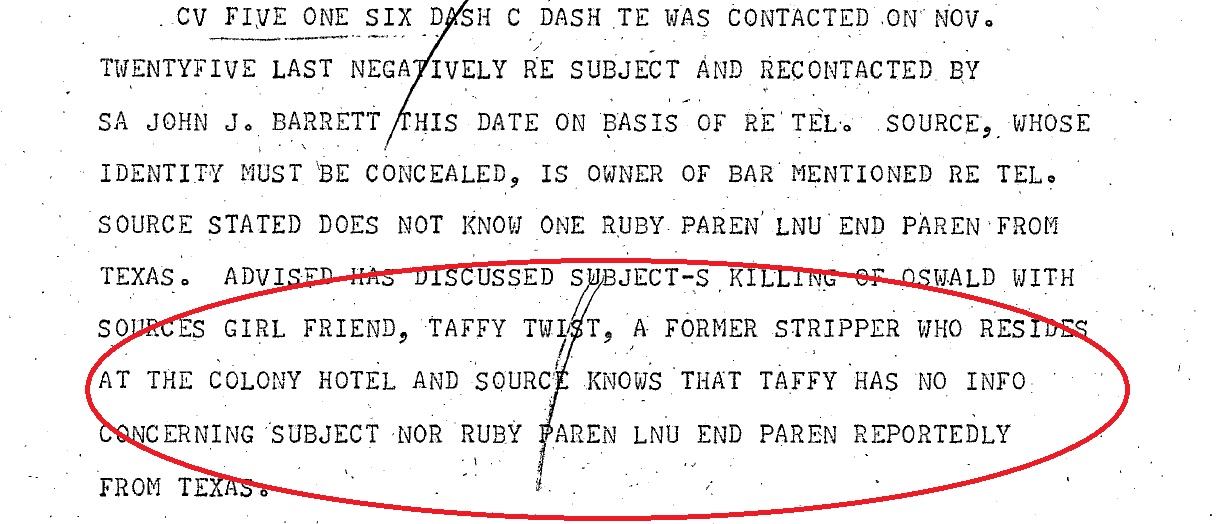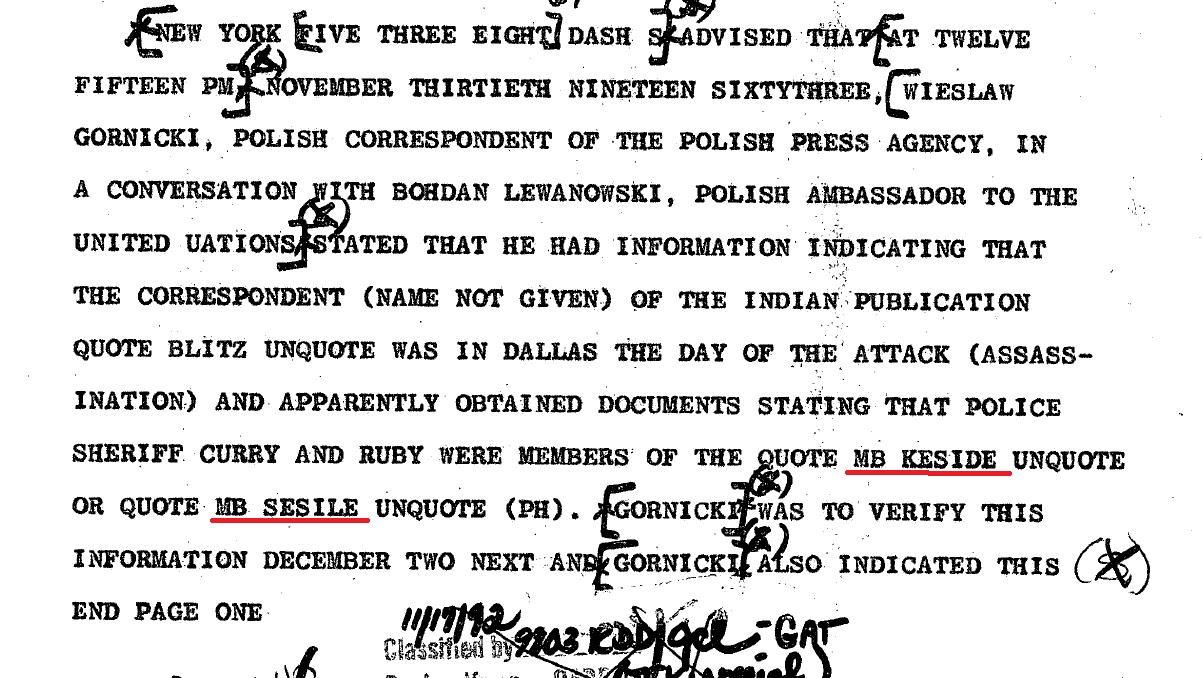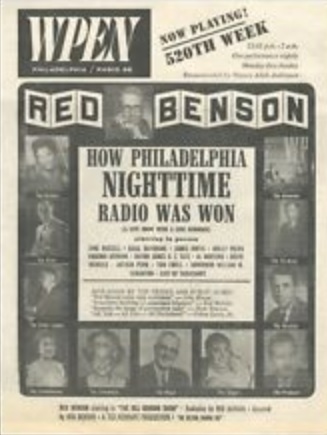JFK files reveal Hoover's prurient interest in sex
By The Wayne Madsen Report
While the partially-released JFK assassination files contain some nuggets of interest that fill in the gaps for some of the events that transpired before, during, and after the November 22, 1963 assassination of President John F. Kennedy, there are a few FBI memos that point to its director's penchant for gathering intelligence on prurient sexual matters. Hoover, who is now recognized by many historians as being a closeted homosexual, maintained an extensive card filing system that included information that could be used to blackmail politicians and other prominent citizens.
FBI agents assigned to investigate Lee Harvey Oswald assassin Jack Ruby appeared anxious to whet Hoover's appetite with memos regarding Ruby's female "employees." One air telegram sent from the FBI office in Los Angeles concerned a former Ruby night club stripper named Marjorie Alice Putnam. A January 7, 1964 Airtel implies that Putnam, who went by the stage name "Syra the Dutch Doll," moved to Hollywood, California after working for Ruby in Dallas.
An earlier FBI telegram from the FBI office in Cleveland to Hoover and the FBI Dallas office, dated November 27, 1963, five days after Kennedy's assassination, concerns a former stripper named "Taffy Twist," who denied to the FBI knowing Ruby. For the FBI to be chasing down strippers appears to have been a monumental waste of resources at the time.

A January 30, 1964 Airtel to Hoover from the FBI office in San Francisco also dwells on sexual information. Dr. Walter Bromberg, a resident of Sacramento, was one of Ruby's defense team psychiatrists. After the FBI in San Francisco determined that Bromberg had not been a member of the Communist Party, the FBI San Francisco office noted that a Napa, California source, a nurse, reported that Bromberg, who was married, "conducted sex parties in which he struck women companions with a whip."

A June 21, 1967 FBI memo concerns a bureau interview with Lillie Mae McMaines, a New Orleans friend of Perry Russo, one of New Orleans District Attorney Jim Garrison's chief witnesses and an associate of CIA-linked businessman Clay Shaw, aka Clem Bertrand. McMaines used the name Sandra Moffett while living in New Orleans. After dating Russo and becoming pregnant by him, Russo told her to "get lost." During the time she dated Russo, she stated that he "photographed her on several occasions while she was engaging in the act of coitus with different men." Moffett later turned to prostitution to support herself. On another occasion, Russo wanted Moffett and a girl named Kathy to engage in a lesbian act so he could photograph it. Moffett/McMaines was used by Garrison to prove the association of Russo with JFK assassin co-conspirator David Ferrie. The FBI memo states that Moffett/McMaines "told substantially the truth" during a polygraph examination.
The newly-released files also contain a wealth of information on the activities of Ruby, aka Jacob Rubinstein, in Chicago. A November 25, 1963 telegram from the FBI office in Chicago to Hoover and the Dallas FBI office refers to "Jack Leon Ruby" being a relative of a notorious Chicago gangster named Harry Rubinstein, the owner of the Olympic Hotel on North Clark Street in Chicago's Near North Side. Harry Rubinstein killed a man at his hotel in the mid-1940s but, by paying $25,000 to a Chicago cop, was able to have the homicide charge dropped to manslaughter with one year of probation. Ruby worked for Rubinstein as a bartender at the Banker's Building in the Chicago Loop. Ruby tried to enlist in the Navy in 1942/1943 but failed the physical examination.
The FBI, relying on an informant, noted that Jack Ruby, whose nickname was "Sparky," was an "excellent fist fighter" who operated a bookie operation out of his friend Abe "Zuckie" Zuckerman's restaurant on Roosevelt Road in north Chicago during the World War II years. Because Zuckerman failed to cut Chicago hoodlum Leonard Partick in on the bookie profits, Patrick had Zuckerman shot to death.
Due to the second page being suspiciously missing from the November 25, 1963 FBI telegram, the full context of the FBI's statement that Ruby's gangster associates provided three of the four guns used by Puerto Rican nationalists who, on March 1, 1954, opened fire from the visitor's gallery of the U.S. House of Representatives on to the House floor, is incomplete. Wounded in the attack were Alvin M. Bentley (R-MI), who was shot in the chest; Clifford Davis (D-TN), wounded in the leg; Ben F. Jensen (R-IA), also shot in the back; George Hyde Fallon (D-MD); and Kenneth A. Roberts (D-AL).
A December 12, 1964 telegram from the FBI in Chicago to Hoover and the Dallas field office provides information on a Ruby associate named Paul Dorfman, who had infiltrated, on behalf of the mob, the Waste Paper Handlers Union in Chicago. Bob Mullenix, a private investigator hired to probe Dorfman's involvement with the union, was killed in an "auto accident" in November 1962, a year before JFK's assassination. Mullenix's files on Dorfman and, presumably Ruby, were sent to his brother, John C. Mullenix, in Springfield, Illinois for safekeeping. The FBI Springfield office was tasked with reviewing those files.
There is a fascinating radio telex message from the FBI in New York to Hoover and the Dallas field office, dated November 30, 1963, that provides information on a link between Ruby and Dallas Police Chief Jesse Curry. The telex is titled "Possible Association Between Jesse Curry, Chief of Police, Dallas, Texas, and Ruby." The New York FBI source was the Polish Press Agency's New York correspondent Wieslaw Gornicki. Gornicki relayed a conversation he had with Poland's United Nations ambassador Bohdan Lewanowski. The ambassador told Gornicki that the correspondent for the Indian publication "Blitz" was in Dallas on the day of the assassination.
The Indian reporter told Lewanowski that he had obtained documents indicating that Ruby and Curry were members of "MB KESIDE" or "MB SESILE." These appear to be CIA digraphs followed by cryptonym used to denote various covert operations. For example, "MK" denoted the CIA's Technical Services Division operations in the 1950s and 60s, while "MH" denoted the CIA's worldwide operations. MHCHAOS was the CIA's anti-Vietnam War protest surveillance operation and LITEMPO was a CIA spy operation in Mexico. [UPDATE: Among the newly-released documents is an October 11, 1963 message from the CIA station in Mexico City referring to the implementation of the program with the digraph/cryptonym combination of LCFLUTTER. The "MB" reference may be the CIA's digraph for operations targeting President Kennedy in Dallas in 1963. LCFLUTTER was a CIA program to use Sodium Amytal (amobarbital), Sodium Pentothal (thiopental), and Seconal (secobarbital) in a targeted individual to induce regression]. It is intriguing how a correspondent for a magazine in non-aligned India came to share such information with the ambassador of a Communist country in New York. However, the Indian and Polish reporters, as well as the ambassador, may have been CIA informants.

Another, much later message, dated October 6, 1975, from the FBI Dallas to FBI headquarters in Washington, states that Dallas Morning News reporter Earl Golz "came into possession of documents three years ago from Paul Rothermel, a former Special Agent, FBI, and former Chief of Security, for Hunt Oil Company, Dallas, Texas." One of the documents, dated November 4, 1963, is from "Rothermel to H. L. Hunt (now deceased) which states Rothermel was told by a reliable source that there would be violence along the parade route to be taken by the President John F. Kennedy. The communication further states Rothermel reported this information to Dallas Police Dept., and the FBI." The FBI message refers to Golz as a person who believed in a "conspiratorial plot to assassinate the president," an all-too-familiar pejorative, crafted by the CIA and used by Warren Commission junkies.
While the FBI sought to damage the credibility of journalists like Golz, it had its own informants within the news media. A December 5, 1963 memo to Hoover from the FBI office in Philadelphia concerns an effort to discover the
 identity of a "JHC" who "sent a letter to Dallas," and a post card to radio station WPEN in Philadelphia that concerned Ruby. The FBI telex states that Theodore Reinhart, the producer of the night talk program, the Red Benson Show on WPEN, was an "established source" for the FBI. Reinhart used the Red Benson Show to appeal to "JHC," who apparently called into the Red Benson Show sometime after January 1, 1963 and before November 22, 1963 with information concerning Ruby and the planned assassinations of JFK and Lee Harvey Oswald, to "come forward" with his or her identity. There is no indication that "JHC" ever surfaced.
identity of a "JHC" who "sent a letter to Dallas," and a post card to radio station WPEN in Philadelphia that concerned Ruby. The FBI telex states that Theodore Reinhart, the producer of the night talk program, the Red Benson Show on WPEN, was an "established source" for the FBI. Reinhart used the Red Benson Show to appeal to "JHC," who apparently called into the Red Benson Show sometime after January 1, 1963 and before November 22, 1963 with information concerning Ruby and the planned assassinations of JFK and Lee Harvey Oswald, to "come forward" with his or her identity. There is no indication that "JHC" ever surfaced.A May 8, 1964 FBI memo to the FBI's third-in-charge William Sullivan reports on an interview with Ned Touchstone, an FBI informant, editor of the Citizens' Council of Louisiana publication The Councilor, and member of the Original Knights of the Ku Klux Klan, who reported that President Lyndon Johnson "was formerly a member of the Klan in Texas during the early days of his political career." Sullivan was shot to death on November 9, 1977 in New Hampshire when a local hunter said he mistook him for a deer. Sullivan was due to testify before the House Select Committee on Assassinations. The shooter's father was a New Hampshire state policeman at the time of the incident.
A July 25, 1969 FBI memo concerns a report from Charles William Thomas, a diplomat who served as Political Officer at the U.S. embassy in Mexico City from 1964 to 1967. Thomas related how the famous Mexican play-right [sic] Elena Garro de Paz told him about a party she attended at the home of her cousin Ruben Duran sometime before the JFK assassination. At the party, she was introduced to Oswald and two other Americans. The memo stated that, at the time of the party, there was a close association between the CIA station chief in Mexico City, Winston Scott, and President Gustavo Diaz Ordaz, who served as Interior Minister before becoming president in 1964. With the CIA controlling the Mexican Interior Ministry, the so-called "surveillance" of Oswald consorting with Soviet diplomats in Mexico City is highly dubious, considering the links between the CIA, FBI, and the Mexican security services at the time. Thomas's report states that the CIA was "considerably disturbed" by de Paz's recollection of the meeting with Oswald and the two unidentified Americans and information she ascertained at the time about a plot to kill President Kennedy.
